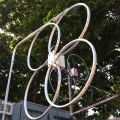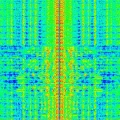Powernumpty
About
- Username
- Powernumpty
- Joined
- Visits
- 5,458
- Last Active
- Roles
- Member
- Points
- 29
-
OpenWebRX [using a transverter/down-converter with the Kiwi]
I tried my old 144MHz-28MHz transverter and was OK on some parts of the airband, not very clean though.
Perhaps you could send an enquiry to transverters-store.com, they seem good value even though you would be using just the RX side.
I looked for other downconverters and maybe due to RTL SDR @£10 world there is very little call for it so prices reflect the specialised nature. -
GPS Problems
You could try a reflector behind it. I don't think I'd get much here facing west but there could be some other interference desensing it.
I'd also carefully check the voltage at the SMA pins 3.3V.
Is there any way you could actually put the puck outside (away from other kit) even if you have to remove the HF antenna?
To me it would be good to test it where it should work before assuming there is some fault. -
Spur Reduction
This is one reason why I love the Kiwi, take a laptop/tablet/phone out to the feed line and try stuff while watching the waterfall, harder to do with other receivers.
I ran one channel on a PC set to slow waterfall and then an Android tablet right at the change I was testing, that way when I got back to the PC I could see if my perceived improvements actually showed up on the slow one. Just had to do it when the local QRM was out shopping. -
Power issues.
The things that may help may be minimising the length of any DC leads and improving or removing mating connectors.
The Kiwi takes very little power but light wiring or poor connectors could exacerbate any momentary current issues.
Imagine this the PSU may be just capable of getting the 5V up in the time the Beaglebone requires, but the wiring/connectors drop just enough in resistance to delay the full voltage. It's a long shot but worth experimenting with before looking for other supplies.
The issue is also not specifically the supply being not clean it's just the time taken for the voltage at the Beaglebone (through wiring and Kiwi DC filtering) to get where it needs to. From other posts and personal experience increasing the voltage by about 0.3V can sometimes help. The ideal solution would be have some way to remotely switch the DC side once the PSU is powered.
There are quite a few IOT switches, networked relay boards or add ons for say Raspberry PI. -
Kiwi for VHF/UHF
Just playing with an Adalm Pluto with third party firmware.
No band filtering of course and it's sold as a learning tool rather than an SDR but still fun to start (a narrow) OpenWebRX between 70MHz and 6GHz.
The CPU is good for only about 900khz when used this way with an USB to ethernet adapter. It is clunky to have to use SSH to start and stop OpenWebRX at different frequencies but I can't help feeling it's a good device for a modular testbed and various software.
The designed bandwidth is 325 MHz to 3.8 GHz but it is simple to open up (out of spec) for experimentation. I only got this one because SDR Console was adding TX support and I thought I'd take a look.
Paging and Tetra knock it about here badly, so it works better on a lower gain antenna until I can arrange some filtering.
Sold to get people using the chips it is well priced for a RX/TX test rig (IMO). -
wifi on BBG (MT7601)
Easiest route is probably something like the TP-Link nano routers (E.G. Tl-wr802n), powered from 5V.
It connects to the Kiwi/BB via ethernet cable.
That set up is good because it offers more placement options for best WiFi link.
I have used that one and it was easy to set up as the Kiwi is treated just like any other wired device connected to the nano router. -
Audio queue depth slowly drops to zero, then resets, causing audio underrun - 8 receiver mode
-
Audio queue depth slowly drops to zero, then resets, causing audio underrun - 8 receiver mode
-
wifi on BBG (MT7601)
Easiest route is probably something like the TP-Link nano routers (E.G. Tl-wr802n), powered from 5V.
It connects to the Kiwi/BB via ethernet cable.
That set up is good because it offers more placement options for best WiFi link.
I have used that one and it was easy to set up as the Kiwi is treated just like any other wired device connected to the nano router. -
PSU - identify the 34p one
I'm sure there are many older supplies designed when compliance was "a thing", I've got a few that seem pretty good but I'm keen to find resonable current options for those people without decent "junk" reserves ;-).
I hadn't tried these tiny PCB's simply as I had assumed the noise would be too intrusive but a comment on here prompted me to look. Linear supplies are getting harder to find more so considering switchers are often listed a "linear" now. In fact I'm getting annoyed with the amount of fake carp on Ebay, can't trust many listings now around power supplies, I still look for older stuff with full traceable approvals.







